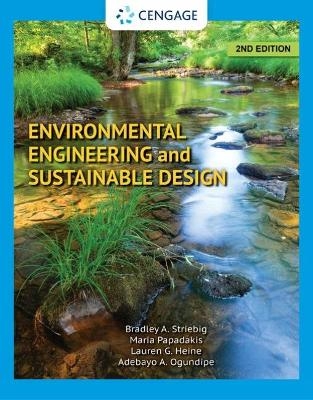
Environmental Engineering and Sustainable Design
CL Engineering (Verlag)
978-0-357-67585-4 (ISBN)
Professor Bradley Striebig received his doctorate in environmental engineering from Pennsylvania State University. He has over 25 years of experience in designing pollution control systems and has worked to improve community resources in Benin, India, Kenya, Malta, Rwanda and throughout the United States. He has served as editor for several journals in the fields of engineering education and engineering for sustainable development. He has led award-winning funded research initiatives, the results of which have contributed to several books, journal articles and peer-reviewed conferences. Dr. Adebayo A. Ogundipe has held academic positions at Stevens Institute of Technology and the Polytechnic Institute of New York University. He earned his Ph.D from Stevens Institute of Technology. His current areas of specialization and scholarship include life-cycle analysis, industrial ecology and developing methods for assessing sustainability. Dr. Maria Papadakis is a political economist with expertise in energy management and the role of energy in sustainable development. She earned her Ph.D. from Indiana University and has 30 years of experience with technology and manufacturing, energy and sustainable production systems. Dr. Papadakis' research has been published in specialized reports of the National Science Foundation and in such journals as Evaluation and Program Planning, Journal of Technology Transfer, The Scientist and the International Journal of Technology Management. Heine earned her doctorate in Civil and Environmental Engineering from Duke University. She is one of America's leading experts in applying green chemistry, green engineering, and design for the environment for sustainable business practices. As Senior Science Advisor for Clean Production Action and as Principal for the Lauren Heine Group, she guides organizations seeking to integrate green chemistry and engineering into their product and process design and development activities - eliminating toxics and the concept of waste and moving toward economic, environmental and communict sustainability. Specific areas of expertise include the development of technical tools and strategies for identifying greener chemicals, materials, and products and facilitation of multi-stakeholder initiatives - particularly those that are technically based.
PART I: ENVIRONMENTAL AND SUSTAINABILITY SCIENCE PRINCIPLES
1. Sustainability, Engineering, and Design.
Introduction. Human Development Index. Sustainable Development and Social Ethics. Sustainable International Development and the Essential Needs of People. Engineering and Developing Communities. Definitions of Sustainability. Populations and Consumption. Technical Approaches to Quantifying Sustainability. Productivity, Consumption, and the Ecological Footprint. The Difficulty of Environmental Valuation. Summary. Problems.
2. Analyzing Sustainability Using Engineering Science.
Introduction. Elemental Analysis. Solubility and Henry’s Law Constant. The Ideal Gas Law. Chemistry of Natural Systems. Equilibrium Models for Estimating Environmental Impacts. Environmental Fate and Partitioning of Chemicals. Summary. Problems.
3. Biogeochemical Cycles.
Introduction. Energy and Material Flows in Ecosystems. Biogeochemical Cycles. The Hydrologic Cycle. Watersheds and Runoff. Water Budget. Nutrient Cycles. Summary. Problems.
4. Material Flow and Processes in Engineering.
Introduction. Material Balances with a Single Reaction. Material Balances with Multiple Materials. Material Balances with Reactors. Defining the Order of Reactions. Half-Life and Doubling Time. Consecutive Reactions. Reactors and Material Flow. Reactor Models. Summary. Problems.
5. Natural Resources, Materials, and Sustainability.
Introduction. Sustainability and Natural Resources. The Nature of Natural Resources. From Natural Resources to Engineered Materials. Sustainability and the Linear Materials Economy. Waste Management and Material Life Cycles. Summary. Problems.
6. Hazardous Substances and Risk Assessment.
Introduction. Understanding Hazard and Risk. Legal Frameworks for Managing Hazardous Substances. Risk Assessment. Hazardous Waste. Radioactive Waste Management. Summary. Problems.
PART II: ENGINEERING ENVIRONMENTAL AND SUSTAINABLE PROCESSES
7. Water Quality Impacts.
Introduction. The Water Crisis. Water Quality Parameters. Modeling the Impacts of Water Pollutants. Water Treatment Technologies. Summary. Problems.
8. Wastewater Treatment.
Introduction. Wastewater Treatment. Preliminary and Primary Treatment. Secondary Treatment. Nutrient Removal. Tertiary Treatment. Sludge Treatment and Disposal. Water Recycling and Reuse. Summary. Problems.
9. Impacts on Air Quality.
Introduction. Air Quality History and Regulations. Health Effects of Air Pollutants. Estimating Emissions of Air Pollutants. Dispersion of Air Pollutants. Air Pollutants from Combustion Processes. Air Pollution Control Technologies. Global Impacts of Air Pollutants. Summary. Problems.
10. The Carbon Cycle and Energy Balances.
Introduction. Climate Science History. Carbon Sources and Emissions. The Carbon Cycle, Carbon Flow Pathways, and Repositories. Global Energy Balance. Global Energy Balance and Surface Temperature Model. Greenhouse Gases and Effects. Climate Change Projections and Impacts. Carbon Dioxide Mitigation, Capture, and Storage. Summary. Problems.
11. Energy Conservation, Development, and Decarbonization.
Introduction. The Challenge of Decarbonization. Energy and Natural Resources. Carbon Footprinting and Embodied Energy. Decarbonization through Energy Conservation. Decarbonization through Low- and No-Carbon Resources. Decarbonization through Electrification. The Water–Energy–Food Nexus. Summary. Problems.
PART III: DESIGNING RESILIENT AND SUSTAINABLE SYSTEMS
12. Designing for Sustainability.
Introduction. Sustainable Design in Context. Sustainable Design Philosophies. Ecological Approaches to Design in Practice. Chemistry, Carbon, and Circularity in Practice. Green Engineering and Green Chemistry in Practice. Product Design Strategies. Designing for Value Recovery. Designing for Process and System Sustainability. People-Centered Design. Summary. Problems.
13. Industrial Ecology.
Introduction. Industrial Metabolism. Eco-Industrial Parks (Industrial Symbiosis). Materials Flow Analysis (M
| Erscheinungsdatum | 13.04.2022 |
|---|---|
| Sprache | englisch |
| Maße | 211 x 51 mm |
| Gewicht | 2132 g |
| Themenwelt | Technik ► Bauwesen |
| ISBN-10 | 0-357-67585-1 / 0357675851 |
| ISBN-13 | 978-0-357-67585-4 / 9780357675854 |
| Zustand | Neuware |
| Informationen gemäß Produktsicherheitsverordnung (GPSR) | |
| Haben Sie eine Frage zum Produkt? |
aus dem Bereich


